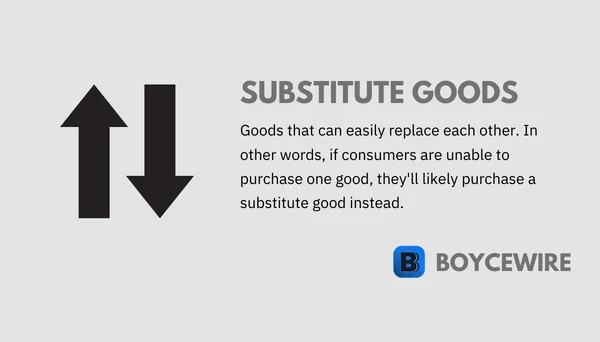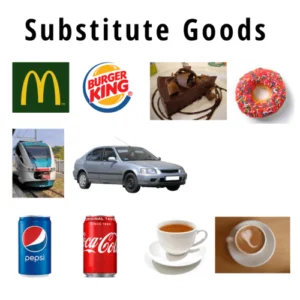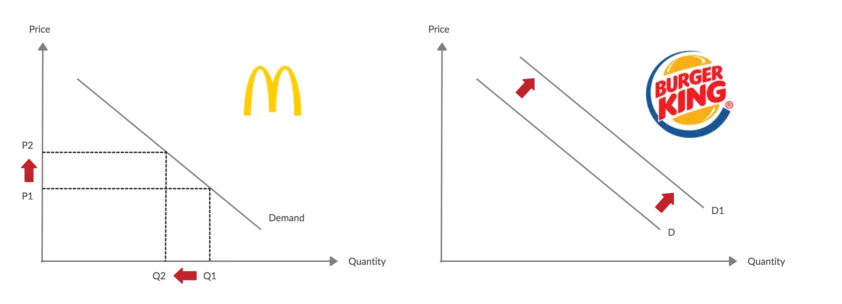Substitute Goods: What it is, Types & Examples

What are Substitute Goods
A substitute good can refer to both physical products and services, as it is any product or service that can be used in place of another. For instance, if the price of one product increases, consumers may opt for a substitute that is cheaper or more accessible.
This means that substitute goods can be seen as similar products that can serve the same purpose or function. For instance, the iPhone and Galaxy Note can be considered substitutes since they both act as mobile phones. In this way, they provide consumers with different options to fulfill the same need.
Key Points
- A substitute good is defined as a product or service that is used in place of another.
- When the price of one substitute good goes up, the demand for the other substitute also goes up – this is known as positive cross price elasticity.
- Substitute goods are highly competitive as they can be easily replaced by a competitor.
Substitute goods are important for maintaining a competitive environment, which helps to keep prices down and quality up. When the price of one good increases, the demand for a substitute good tends to increase as well.
For example, if the price of McDonald’s Big Mac increases from $9 to $15, customers may choose to purchase a burger from Burger King for $9 instead. This ensures that businesses cannot simply raise prices without consequence and must remain competitive in order to retain their customer base.
Substitute Goods Examples
There exist two types of substitute goods, namely direct and indirect substitutes. A direct substitute is a scenario where two commodities can be interchanged without difficulty, such as Pepsi and Cola.
On the other hand, an indirect substitute is a situation where two goods can be replaced by each other, but with a low level of correlation. An instance of this would be bowling and dancing. In case the customer’s dance class is cancelled, they might decide to enjoy a game of bowling instead. However, it is worth noting that these two products are not typically utilized as replacements for one another.
Having said that, let us now examine a few examples.

Direct Substitute Examples
- Pepsi and Coca-Cola
- McDonalds and Burger King
- Playstation and Xbox
- Supermarket-branded and Branded products
- Transport by Car or Train
- iPhone and Samsung Galaxy
- Pizza Hut and Domino’s
- Physical Books and Kindle
In-direct Substitute Examples
- Dancing and bowling
- Bowling and Video games
- Banana and Doughnuts
Direct Substitute Goods
Goods that are classified as direct substitutes possess a high level of similarity and have many common characteristics. For instance, Coca-Cola and Pepsi are direct substitutes in the soda market. They are also known as ‘within-category substitutes’ or ‘close substitutes’.
“Direct Substitutes share many common characteristics, but most importantly, consumers readily switch between the two.”

Direct substitute goods have a characteristic known as high cross-elasticity of demand. This means that two products can be easily interchanged. For example, there may be a branded bag of flour and an own-branded one. Customers’ preferences may be heavily influenced by any changes in variables, particularly price.
In particular, direct substitute goods exhibit a high cross-elasticity of demand. If the price of Coca-Cola increases and its sales drop by 10 percent, then the sales of Pepsi may rise by approximately 10 percent. In other words, when there is a significant correlation between the two goods, they can be regarded as direct substitute goods.
In-direct Substitute Goods
Indirect substitute goods can arise from industries or categories that appear to be unrelated. For instance, if the price of bowling increases, some customers may opt to purchase more video games instead. Although these products come from different industries and are different in nature, a portion of consumers may readily substitute one for the other.

Indirect substitute goods typically have a low cross-elasticity of demand. For example, a customer might go to a store to buy a doughnut, but if none are available, they may decide to purchase a banana instead. These two items are entirely different, yet they can still be substituted for one another.
Since indirect substitutes are not very common, they tend to have a weak correlation, which results in a low cross-elasticity of demand. For instance, if the price of bowling increases and its sales decline by 10 percent, the increase in video game sales may only be around 1 percent. The relationship between the two products is therefore feeble. Nevertheless, it is crucial for marketers to take this into account.
Factors that affect Substitute Goods
The illustration below demonstrates that when McDonald’s raises its prices, the demand for Burger King increases. However, it is important to note that price is not the only variable to consider when assessing the power of substitution. There are various other factors that come into play.
Substitute goods fulfill consumer needs when there is a change in a particular variable. Various factors such as price, quality, and geography can come into play. If any of these factors change, substitute goods can become relevant.
For instance, you may typically purchase a freshly made doughnut from a local bakery every day. However, one day the quality of the doughnut decreases, and it becomes dry and tasteless. In such a scenario, you might consider substituting it with other options such as cakes, waffles, or any other similar products. Any item that is purchased instead of the doughnut can be regarded as a substitute good.
Why Consumers Choose Substitutes
Consumers choose substitutes for a number of reasons. Let us look at some of them below:
1. Price
Price is perhaps the most common reason why customers consider substituting goods. For instance, in a restaurant, a pint of beer may cost $10 while a cola may cost $3. In such a scenario, the customer would need to believe that the beer is worth an additional $7 to them. Each individual places a certain value on each product, and they make their decision based on their preference for one product over the other. These decisions are often made subconsciously.
2. Quantity
Quantity and supply can also impact consumers’ decisions to purchase substitute goods. For instance, if the last iced-ringed doughnut is sold out at the local grocery store, customers may look for substitute goods instead.
3. Quality
Quality is another factor that can influence the demand for substitute goods. If a product does not taste good, does not last long, or is not comfortable, customers may consider other options. For example, there may be a run-down restaurant around the corner that produces food that is okay, but the lower quality is taken into account alongside pricing.
4. Geography
Geography is also a crucial variable to consider when purchasing substitute goods. There may be two supermarkets; one that is on the way home from work, and another that is 15 minutes out of the way. The geographical location of the store provides convenience for the customer, and they take this into account when deciding on a product.
5. Tastes
Consumer tastes can change over time, which can affect the demand for substitute goods. For instance, there may be a craze or a festive product that is only available at certain times of the year. Mince pies, which are only available at Christmas, may be a substitute for other bakery goods, but the seasonality of the product adds extra value for the customer.
6. Income
On a micro level, growth in income can also impact consumer behavior. For example, as their income increases, consumers may start buying more lean cuts of steak instead of less expensive options. As incomes rise, the price of a good becomes less of a factor when considering substitute goods.
FAQs
A substitute good is not necessarily just a physical product; it can also be a service. Essentially, it is a product or service that is used in place of another.
Some examples of substitute goods include:
Direct examples include:
• Pepsi and Coca-Cola
• McDonalds and Burger King
• Playstation and Xbox
• Supermarket-branded and Branded products
• Transport by Car or Train
• iPhone and Samsung Galaxy
• Pizza Hut and Domino’s
• Physical Books and Kindle
Indirect examples include:
• Dancing and bowling
• Bowling and Video games
• Banana and Doughnuts
Substitute goods are two goods that can be used in place of one another, for example, Dominos and Pizza Hut. By contrast, complementary goods are those that are used with each other. For example, pancakes and maple syrup.
The key difference is that substitute goods replace one another, whilst complementary goods add value to the other.
The availability of substitute goods can affect demand by providing consumers with alternative options, which can lead to a shift in demand away from a particular product or service.
The price of substitute goods can affect demand by making one product or service more attractive than another. If the price of a substitute good increases, consumers may switch to a lower-priced alternative.
About Paul
Paul Boyce is an economics editor with over 10 years experience in the industry. Currently working as a consultant within the financial services sector, Paul is the CEO and chief editor of BoyceWire. He has written publications for FEE, the Mises Institute, and many others.

Further Reading
 Unit Elastic - Unit elastic demand refers to a situation where a change in price leads to an equivalent proportional change in quantity…
Unit Elastic - Unit elastic demand refers to a situation where a change in price leads to an equivalent proportional change in quantity…  Elastic Demand - Elastic demand refers to a situation where a change in price results in a relatively larger change in quantity demanded.
Elastic Demand - Elastic demand refers to a situation where a change in price results in a relatively larger change in quantity demanded.  Third Degree Price Discrimination: Definition, Examples & Graph - When business charge customers different prices based on their demographic or other characteristic.
Third Degree Price Discrimination: Definition, Examples & Graph - When business charge customers different prices based on their demographic or other characteristic. 